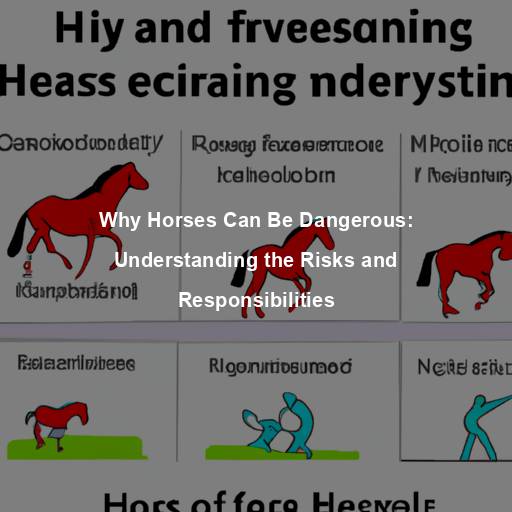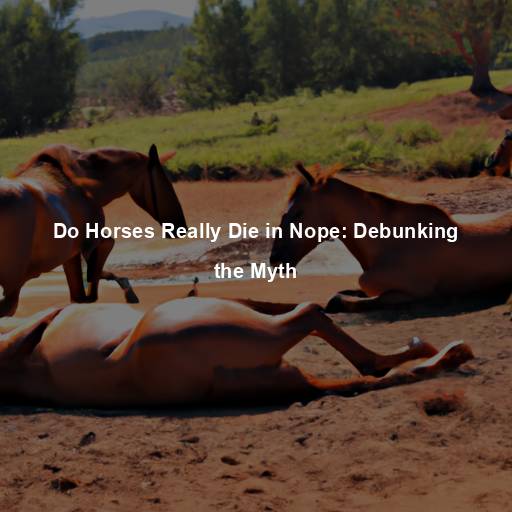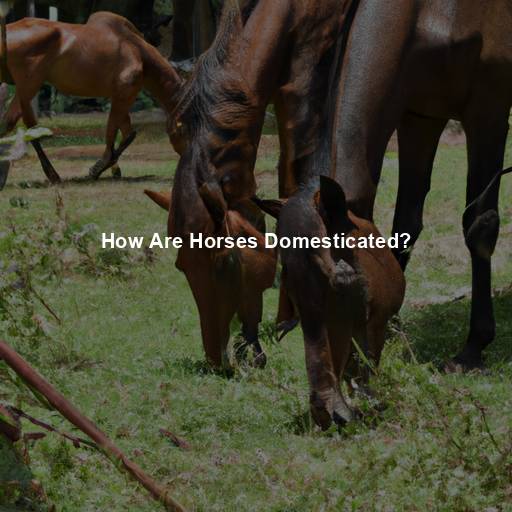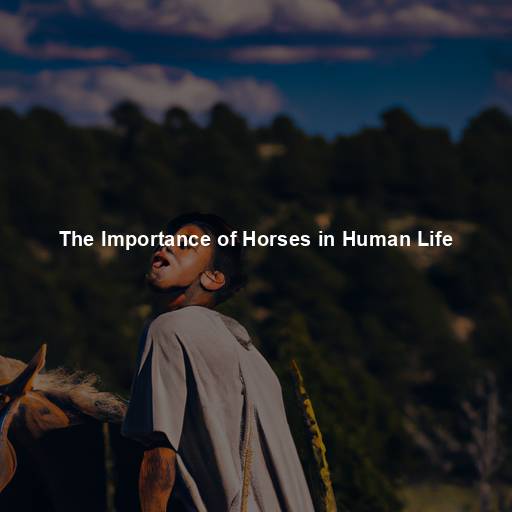Why Horses Can Be Dangerous: Understanding the Risks and Responsibilities
Last Updated on October 25, 2023 by Evan
Contents [hide]
- 1 The Majestic Creatures That Inspire Awe
- 1.1 The Power and Size of Horses
- 1.2 Flight Response and Unpredictability
- 1.3 Kicks and Bites: Natural Defense Mechanisms
- 1.4 Lack of Understanding and Miscommunication
- 1.5 Improper Handling and Lack of Training
- 1.6 Riding Accidents and Injuries
- 1.7 Health Risks and Zoonotic Diseases
- 1.8 Responsible Horse Ownership and Education
- 1.9 Establishing Boundaries and Communication
- 1.10 Understanding Body Language and Behavior
- 1.11 Safety Precautions: Equipment and Facilities
- 2 The Role of Education and Experience
- 3 The Importance of Routine Care and Health Maintenance
- 4 The Role of Risk Assessment and Preparedness
- 5 FAQs – Why are horses dangerous?
The Majestic Creatures That Inspire Awe
For centuries, horses have mesmerized us with their elegance, strength, and captivating presence. Their majestic gallops and the way they tenderly nuzzle us have forged an unbreakable connection between humans and these magnificent beasts. Yet, amid their enchantment, it is crucial to acknowledge the inherent risks that come with interacting with horses. This article aims to unravel the enigmatic reasons behind their potential danger, while shedding light on the unwavering responsibilities that accompany the privilege of engaging with these awe-inspiring creatures.
The Power and Size of Horses
The sheer strength and magnitude of horses can pose a significant risk, making them a force to be reckoned with. These majestic creatures can range in weight from 900 to a staggering 2,200 pounds, surpassing the expectations of many. With their robust physique and remarkable swiftness, horses emerge as formidable beings. In instances where horses feel unsettled, anxious, or provoked, their innate reaction might be to either bolt or lash out, potentially causing harm to unsuspecting bystanders.
Flight Response and Unpredictability
The majestic horses, known for their grace and strength, possess an innate survival instinct that often defines their behavior. As prey animals, their response to perceived danger is instinctual, a burst of energy propelling them away from harm’s way. This unpredictability, interwoven with their natural flight response, adds an element of perplexity when encountering unfamiliar scenarios. Even the most impeccably trained horses can showcase unexpected behavior when confronted with stressors, be it a sudden movement, a cacophony of noises, or the perplexing nature of unfamiliar surroundings.
Kicks and Bites: Natural Defense Mechanisms
Horses have evolved powerful defense mechanisms in the form of kicks and bites. These responses are instinctual and can cause serious injuries or even fatalities. A horse’s kick can deliver a tremendous amount of force, capable of fracturing bones or causing severe internal injuries. Their bites, though less common, can also be dangerous, especially if directed towards vital areas of the body.
Lack of Understanding and Miscommunication
Another reason why horses can be dangerous stems from a lack of understanding and miscommunication between humans and these animals. Horses communicate primarily through non-verbal cues, such as body language and subtle signals. Misinterpreting these cues or failing to recognize signs of distress can lead to accidents or injuries. It is crucial for horse handlers and riders to educate themselves on equine behavior and develop a keen sense of observation to ensure effective communication with their equine partners.
Improper Handling and Lack of Training
Improper handling and a lack of proper training can also contribute to the potential dangers associated with horses. Horses are intelligent creatures that require consistent training and respectful handling to develop trust and obedience. Mishandling a horse, using forceful methods, or neglecting its training needs can lead to behavioral issues, which, in turn, can result in dangerous situations. Responsible horse ownership involves investing time and effort in training, as well as seeking guidance from experienced professionals.
Riding Accidents and Injuries
When it comes to horseback riding, the thrill and excitement are undeniable. However, let’s not forget about the unpredictable nature of this exhilarating activity. Mishaps on horseback can be triggered by a medley of factors, including unanticipated tumbles, unexpected encounters, or even the malfunctioning of equipment. Novice riders or individuals who underestimate safety measures face an augmented susceptibility to precarious situations.
Health Risks and Zoonotic Diseases
Horses can harbor certain health risks, including zoonotic diseases that can be transmitted to humans. Equine-related activities, such as grooming, handling manure, or caring for wounds, can expose individuals to potential infections or allergies. It is important to maintain good hygiene practices, use protective gear when necessary, and seek prompt veterinary attention for any signs of illness or injury in horses to safeguard both human and equine health.
Responsible Horse Ownership and Education
In the vast realm of equestrian experiences, the enigmatic nature of horses can leave one awestruck and perplexed. One cannot deny the potential dangers that coexist with these majestic creatures, yet it is imperative to unravel the paradox by delving into the intricacies of responsible horse ownership and the arcane world of equine education. With a penchant for understanding equine behavior, a mindful investment in comprehensive training, and an unwavering commitment to maintaining a secure environment, the labyrinthine risks that surround horses can be shattered into fragments of serenity. Expanding the horizons of education to encompass all who engage with these mystical beings – be it riders, handlers, or the custodians of equestrian realms – will unlock the gates to a harmonious coexistence, where chimerical collaborations between humans and horses thrive.
Establishing Boundaries and Communication
Clear communication is key to establishing boundaries and ensuring the safety of both humans and horses. Horses rely on consistent cues and signals to understand what is expected of them. It is essential to learn how to effectively communicate with horses using body language, voice commands, and rein aids. By setting clear boundaries and reinforcing them consistently, we can establish a respectful and safe dynamic with these magnificent animals.
Understanding Body Language and Behavior
When it comes to the unspoken language of horses, catching their drift can be as fascinating as it is mystifying. These majestic creatures have a whole repertoire of nonverbal cues up their sleeves, from the flick of an ear to the swish of a tail. For those lucky enough to have a front-row seat to their world, learning to decipher these signals becomes paramount. By attuning ourselves to the subtle nuances of their body language, we can navigate their emotional landscape with grace and understanding.
Safety Precautions: Equipment and Facilities
The absolute priority when it comes to the harmonious and secure union of humans and their noble equine companions lies in meticulous attention to detail with respect to equipment and facilities. In order to safeguard the lives that intertwine in this intricate dance, riders must don appropriate protective gear such as robust helmets, sturdy boots, and shielding vests. Furthermore, it is imperative to conduct meticulous and regular inspections of the various elements of the horse’s accoutrements, such as saddles and bridles, in order to apprehend any lurking malfunctions that may pose a threat to their well-being. Lastly, we must not underestimate the crucial role of well-designed equestrian enclaves that embrace safety as their utmost concern, embracing measures such as well-fortified fences, meticulously groomed arenas, and ample luminosity.
The Role of Education and Experience
When it comes to horses, navigating the realm of risk requires a delicate balance of education and experience. Whether you’re a neophyte in the world of horseback riding or a seasoned equestrian, the key is to embrace the infinite journey of learning. Embark on a quest for wisdom by seeking the sagacious counsel of equine experts, wholeheartedly immersing yourself in horsemanship clinics, and eagerly engaging in riding lessons. By continuously expanding your horizons, you’ll forge an unbreakable bond with these majestic creatures, empowering yourself to conquer obstacles and minimize potential hazards along the way.
Professional Guidance and Mentorship
Navigating the labyrinth of the equine realm demands more than just a stroke of luck. In the enigmatic world of horse ownership, the key to unlocking success lies in seeking the guidance of seasoned connoisseurs. Professional trainers and instructors, with their arsenal of knowledge on handling techniques, riding skills, and equine behavior, can be the compass that steers you away from the treacherous currents of uncertainty. By nurturing a relationship with a trusted mentor, you will be armed with the wisdom and sagacity to conquer the perplexing complexities of horse ownership and face any situation with unwavering confidence.
Ongoing Learning and Skill Development
Horse-related knowledge and skills are not acquired overnight but are built over time through ongoing learning and skill development. Stay curious and seek opportunities to broaden your understanding of horses, their care, and their behavior. Attend workshops, read books, and engage in online forums to expand your knowledge base. Continuously refining your horsemanship skills will not only improve your safety but also deepen your connection with these magnificent creatures.
Early Socialization and Desensitization
Creating a strong foundation for our equine companions is nothing short of a marvel. As wild as their spirit may be, it is through early socialization and desensitization that horses are able to navigate the enigmatic terrain of resilience and adaptability. By immersing these majestic creatures in a tapestry of diverse stimuli – be it the rhythmic cadence of unfamiliar environments, the symphony of novel sounds, or the presence of intriguing objects – we gift them with an invaluable tool: confidence. It is this confidence that serves as their armor against the tempestuous winds of fear, shaping them into harmonious beings capable of gracefully navigating the labyrinth of life.
Consistent and Gentle Training Methods
When it comes to training our magnificent equine companions, the key lies in embracing a gentle and consistent approach. By steering clear of harsh and forceful methods, we can unlock a whole new level of compassion and understanding between horse and handler. Not only does this foster a positive bond, but it also helps to keep both parties safe from any unexpected challenges or potentially risky situations. So, let’s embark on this journey of patient and reward-based training, where trust and willingness reign supreme, and where the perplexities of fear and resistance are brushed aside.
Recognizing and Addressing Behavioral Issues
Horses, like humans, can experience behavioral issues that may pose risks to their handlers or other animals. Aggression, fearfulness, or disobedience can be signs of underlying physical discomfort, past trauma, or inadequate training. It is essential to address these issues promptly and seek professional assistance if necessary. A skilled trainer or behaviorist can help identify the root cause of the problem and develop an appropriate training plan to address and manage the behavior effectively.
The Importance of Routine Care and Health Maintenance
Ensuring the optimal condition and welfare of our graceful equine companions remains an utmost priority, rendering significant implications not just for their own serenity, but for the safeguarding of their human counterparts. Understanding the profound interconnectedness of the equine world, it becomes quintessential to commit unwavering diligence towards their welfare, considering the crucial role they play in the lives of their owners, handlers, and riders. By engaging in conscientious efforts and nurturing a symbiotic relationship with these majestic creatures, we embrace the ceaseless pursuit of harmony and mutual well-being, enshrining a tapestry of profound connections and unconventional serendipities.
Regular Veterinary Care
Regular veterinary care is essential to monitor the overall health of horses and detect any potential issues early on. Vaccinations, dental care, deworming, and routine health checks are all integral parts of responsible horse ownership. By staying up-to-date with veterinary appointments, horse owners can ensure that their animals are in optimal health, minimizing the risk of illness or injury.
Proper Nutrition and Weight Management
Ensuring that our beloved equine companions receive a well-rounded and fitting nourishment regime plays a pivotal role in their overall state of bliss. The delicate balance of sustenance not only bolsters their resilient immune system but also serves as a steadfast guardian against unwanted weight fluctuations and potential health woes. However, caution must be exercised as a tightrope walk between overindulgence and deprivation, for veering off-course could usher in a cascade of metabolic disturbances and inadequacies. Seek the guiding wisdom of an equine nutritionist, who shall gracefully design a bespoke feeding blueprint, perfectly aligning with the unique demands of your esteemed steed.
Regular Exercise and Mental Stimulation
Horses, majestic beings of boundless energy, thrive on a plethora of physical exertions and intellectual challenges in order to uphold their holistic well-being. Granting them generous stretches in secure and expansive pastures not only fosters their inherent instincts but also cultivates healthy camaraderie among their equine companions. The sheer potency of regular exercises safeguards against the gnawing perils of ennui and unspent vigor, mitigating the emergence of vexing behavioral conundrums.
Safe Handling and Grooming Practices
Practicing safe handling and grooming techniques is crucial for both the horse’s well-being and the handler’s safety. Horses should be approached calmly and with clear communication. Proper haltering, leading, and tying techniques should be employed to prevent accidents or escapes. When grooming, care should be taken to use appropriate tools and techniques to avoid injuries to the horse’s skin or sensitive areas.
The Role of Risk Assessment and Preparedness
Being prepared for potential risks and having a proactive approach to safety is essential when working with horses.
Assessing the Environment and Surroundings
Before engaging in any horse-related activities, it is crucial to assess the environment and surroundings for potential hazards. Uneven footing, loose objects, or low-hanging branches can pose risks to both horse and handler. Identifying and mitigating these risks, such as by clearing debris or repairing fencing, can help create a safer environment for everyone involved.
Emergency Preparedness and First Aid
When it comes to your majestic equine companion, it’s better to be safe than sorry. Ensuring that you have a well-equipped first aid kit specifically tailored for horses is an absolute must. Equally important is the knowledge and understanding of basic first aid procedures for those unexpected moments when accidents or injuries occur. Staying ahead of the game by acquainting yourself with common equine injuries and having emergency veterinary contact details handy can truly make all the difference in the world.
Safety Protocols for Riding and Handling
When it comes to the majestic world of horse riding, safety is paramount. A harmonious connection between horse and rider is not only a beautiful sight, but it also comes with its share of risks. One must understand the importance of donning the right safety gear such as helmets and boots, while also respecting the specific guidelines of various equestrian disciplines. Handling these magnificent creatures with finesse requires a deep understanding of proper techniques for leading, tying, and even the delicate art of loading horses onto trailers.
FAQs – Why are horses dangerous?
What makes horses dangerous animals?
When it comes to horses, their sheer size and enigmatic nature can be quite imposing. Weighing in at a staggering 1,000 pounds (or even more), these majestic creatures possess an inherent ability to leave us awestruck and, at times, perplexed. With their robust muscles, lethal hooves, and formidable teeth, they can effortlessly defend themselves or inflict harm when they find themselves in precarious situations. Furthermore, their innate instinct to flee, combined with their knack for reacting impulsively to unfamiliar circumstances, adds an extra layer of unpredictability to their already captivating presence.
Are all horses dangerous?
Contrary to popular belief, the notion that all horses are inherently dangerous is far from the truth. The vast majority of these majestic creatures are, in fact, gentle and well-mannered, especially when they have received the proper training and socialization. Yet, like any living being, horses possess unique personalities and temperaments that can vary greatly. Factors such as fear, previous mistreatment, or even underlying health issues can contribute to the manifestation of aggressive or unpredictable behavior in certain horses. It is essential to recognize and appreciate the inherent nature of these magnificent animals and approach them with the necessary understanding, while also ensuring appropriate handling and training methods, so as to mitigate any potential risks associated with their behavior.
What are some specific risks when dealing with horses?
When it comes to engaging with our majestic equine friends, it’s important to acknowledge the complexities and uncertainties that can arise. Venturing near a horse on land carries potential dangers, like unexpected kicks or unintentional trampling that could leave lasting harm. Approaching these magnificent creatures demands a delicate approach, employing mindfulness towards their nonverbal cues and avoiding any sudden or alarming gestures. Moreover, indulging in the thrilling pursuit of horseback riding brings its own assorted perils – the fear of falls or being forcefully dislodged from your noble steed. These hazards only heighten if one neglects proper equipment, fails to acquire adequate training, or disregards essential safety measures. Lastly, let us not overlook the possibility of horses manifesting their dissatisfaction through biting, provoked either by external threats or unwarranted invasions of their personal space. In such scenarios, the consequences can be dire, leaving individuals with significant injuries.
How can I mitigate the risks of working with horses?
When it comes to ensuring a safe horse-handling experience, there are a multitude of steps that can be taken. To begin, acquiring adequate training in horse care and handling is of utmost importance. This entails mastering the ability to decipher a horse’s body language, comprehending their unique behaviors, and confidently managing them in diverse scenarios. It is crucial to approach these majestic creatures calmly, avoiding any abrupt movements that may startle them. Additionally, equipping oneself with the appropriate safety gear, such as helmets and sturdy footwear, serves as an added layer of protection while handling or riding horses. Lastly, forging a bond built on trust and respect with the horse fosters a positive and secure relationship.
Can children be around horses?
Yes, children can be around horses, but it is important to ensure their safety. It is recommended that children always be supervised by responsible adults when interacting with horses. Teaching children the basics of horse behavior, how to approach them cautiously, and reminding them to respect the horse’s personal space can help prevent accidents. Moreover, providing children with age-appropriate riding lessons and instructing them on proper safety measures is essential if they are interested in horseback riding. It is crucial to match children with suitable horses in terms of size, temperament, and experience level to further minimize risks.







